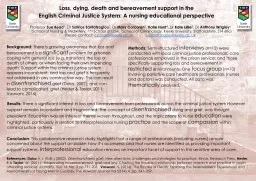

Sotirios Santatzoglou 2 Dr Mary Corcoran 3 Katie Hunt 4 Dr Kate Lillie 5 Dr Anthony Wrigley 6 15 School of Nursing amp Midwifery 246 School of Law 3 School of Criminology ID: 795684
Download The PPT/PDF document "Professor Sue Read 1 , Dr" is the property of its rightful owner. Permission is granted to download and print the materials on this web site for personal, non-commercial use only, and to display it on your personal computer provided you do not modify the materials and that you retain all copyright notices contained in the materials. By downloading content from our website, you accept the terms of this agreement.
Slide1
Professor
Sue Read1, Dr Sotirios Santatzoglou2, Dr Mary Corcoran3, Katie Hunt4, Dr Kate Lillie5, Dr Anthony Wrigley61,5School of Nursing & Midwifery, 2,4,6,School of Law, 3School of Criminology, Keele University, Staffordshire, ST4 6BGPlease contact: s.c.read@keele.ac.uk s.santatzoglou@keele.ac.uk
Loss, dying, death and bereavement support in the English Criminal Justice System: A nursing educational perspective
Background: There is growing awareness that loss and bereavement is a significant problem for prisoners coping with general loss (e.g. transition) the loss or death of others, or when facing their own impending death. Support within the criminal justice system appears inconsistent, and loss and grief is frequently not addressed in any constructive way. This can result in disenfranchised grief (Doka, 2002), and can lead to complicated grief (Hester & Taylor, 2011; Vaswani, 2014).
Methods: Semi-structured interviews (n=12) were conducted with local criminal justice professionals; care professionals employed in the prison service; and those specifically supporting loss and bereavement in restricted environments. One focus group (n=10) involving palliative care healthcare professionals (nurses and doctors) was conducted. All data was thematically analysed.
Results: There is significant interest in loss and bereavement from professionals across the criminal justice system However support remains inconsistent and fragmented. The concept of disenfranchised dying and grief, was thought prevalent. Education was an inherent theme woven throughout, and the implications to nurse education were highlighted, particularly in relation to interprofessional nursing practice and the scope of compassion within criminal justice systems.
Conclusion: This collaborative research study highlights that a range of professionals (including nurses) remain concerned about the support available; how it’s accessed; and that nurses are identified as providing important support systems. Interprofessional education remains an important facet of support in this sensitive area of care.
References: Doka, K.J. (Edit.) (2002). Disenfranchised grief: New directions, challenges and strategies for practice. Illinois: Research Press. Hester, R & Taylor, W. (2011). ‘Responding to bereavement, grief and loss: Charting the troubled relationship between research and practice in youth offending services’ Mortality, Vol. 16, No. 3 pp.191-203. Vaswani, N. (2014). The Ripples of Death: Exploring the Bereavement Experiences and Mental Health of Young Men in Custody. The Howard Journal Vol 53 No 4. pp. 341–359.